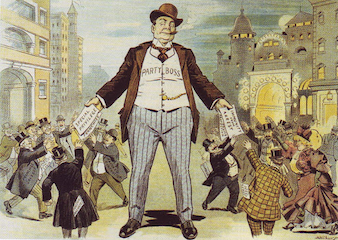
Political Machine. A party organization in representative democracies that recruits members through tangible incentives like money or political jobs. These organizations are characterized by:
Structure and Control
- Hierarchical structure with a high degree of leadership control over member activity
- Often led by a single boss or small autocratic group
- Strong party whip structure to enforce discipline
Key Features
- Reliance on patronage and the spoils system
- Behind-the-scenes control of political processes
- Longstanding political ties within the democratic structure
- Organized on a permanent basis, not just for single elections
Historical Context
- Emerged prominently in the United States during the Gilded Age
- Notable examples include Tammany Hall in New York City (1790s-1960s)
- Often served immigrants as a vehicle for political enfranchisement
- Peaked in influence from the late 19th century to the mid-20th century
Functions and Strategies
- Mobilize voters on election day
- Provide tangible benefits to supporters (e.g., jobs, favors)
- Maintain control through a system of rewards and punishments
- Often associated with corruption and graft
Decline
- Reforms in civil service weakened patronage systems
- New Deal programs nationalized many job benefits
- Assimilation and prosperity of immigrant groups reduced need for machine support
- Most big city machines collapsed by the 1940s, with some exceptions
Political machines have been both criticized for corruption and praised for their role in integrating immigrant communities into the political process.